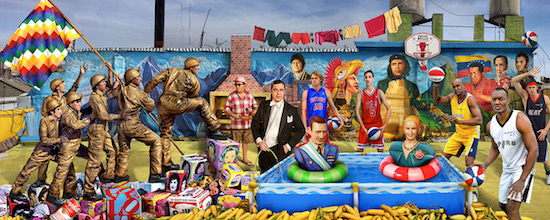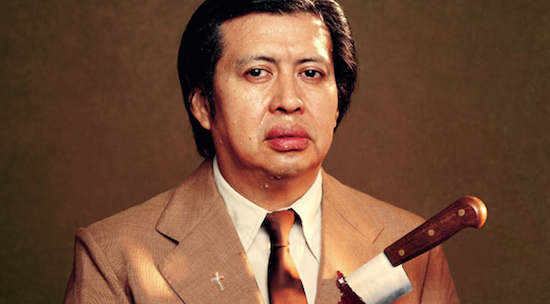We are back to the question of political art – how should artists respond to an age of Novichok and Tomahawks? They can do rage; they can try and out shock. Good luck to them with that. But what if an artist is not that ashamed of the culture they have been born into? What if they want to celebrate their inheritance, even if it has been corrupted by years of Yankee imperialism? What if they even admit to an “ancestral-everlasting inferiority complex”? Maybe you get some of your pointers from Andy Warhol’s deadpan Pop provocations…
Marcos López is an Argentinian post-Pop photographer who clearly loves his country, his continent, but he’s no nationalist. Given the horrors of life under the Generals in the late 1970’s López is well aware of the risks of fascism. His is a sun bright South American vision that is remorselessly skeptical of the North. His Latin American imagery is celebratory but freighted with irony. López is no sneering Martin Parr; there is no condescension here, no taking the piss out of the poor and their cash-strapped taste. He plays with the caricatures but does not mock them. López champions his proletarian background; he roots for the underclass by coating their fixations with hallucinatory colour, what he semi-seriously calls his “sub-tropical pampas digital neo-baroque style”.
The front room is an installation called Suite Bolivariana (2018) and is based on a photographic work López made in 2009 that apparently mimics his own outdoor roof balcony space. A gigantic mural indebted to Diego Riviera covers the L-shape of two walls. The work acknowledges Riviera’s polemical intent and is gloriously and deliriously multi-referential. From the left we see a group of men raising a flag in a pose that quotes the famous photograph by Joe Rosenthal of victorious marines at Iwo Jima. The work in turn appropriates yet another appropriation, this time by Ed Kienholz with his installation The Portable War Memorial (1968). The flag the men carry is more multi-coloured than the Stars and Stripes. Pointedly this is the banner of the indigenous peoples – the Whipala is their seven-coloured symbol and is now legally established as the dual flag of Bolivia. And the men are not soldiers: they represent the insurgent left, a group of Bolivian miners.
Beside them is a benign looking geezer, a barbeque fiend cooking at an asado. He’s proudly holding aloft a morcilla, a black pudding stuck on a prong; he’s happy with his day. And next to him we see the tango master Carlos Gardel resplendent in dinner jacket. López here reminds me of Ian Dury – a cheerily cynical Jack the Lad figure championing all his reasons to be cheerful.
Next, in the middle of the tableaux, Juan and Eva Peron appeal to the political centre. We see them in blue (hot?) water encircled by rubber rings, their frustrated desires for the working classes restrained, restricted, cheapened to the ownership of an inflatable outdoor pool. Towering above them is a line of dreamers, some of the true champions of the continent’s poor – Che Guevara, Hugo Chávez, Simón Bolívar, and José de San Martín stare out with grim intent from on high, atop the hills of Machu Pichu. But who are these big guys in vests barging in front of them? Basketball stars! As we move to the right of the mural López brings us back to today’s world where NBA giants with an orange ball represent the current mutation in North American imperialism, the new way for capitalism to capture hearts and minds.
A pile of oversized kiddies’ building blocks lie scattered below the mural. These are painted in Pop style to look like Warhol’s Brillo boxes; some have images of Andy himself. A few are done with Warhol’s portrait of the ludicrously wealthy Argentinian collector María Amalia Lacroze de Fortabat. And there are piles of real husks of corn lying everywhere – a reference to fellow Argentinian Marta Minujín’s performance work The Debt (1985) where she dramatized the cost of serving the Argentinian overdraft at that time by handing maize to Andy Warhol himself.
Bringing the action right up to date López next sets down a dummy of Argentina’s current president – a relaxed Mauricio Macri – sitting in a deck chair with his shoes off and his feet dipped in a bowl of water. Macri reads a copy of Hello! Magazine with his wife Juliana Awada on the cover, smug in the knowledge that the magazine has chosen her as the most elegant First Lady in the world. This is a nod and a wink to López’s local audience – it just so happens that Awada is into promoting contemporary Argentinian art in a big way…

Elsewhere are some of his earlier photographs such as Familia de sastres (2010) – a shot of an indigenous family – four men, two women, and a kid. They are a family of small tailors seen in their shop. Towering above and behind them is a tailor’s dummy – a stern blonde Aryan (in case we are in any doubt about this a sign nearby reads ‘Germany’) thus López alludes to the decades of immigration to South America from Germany as well as the taint of its Nazi infiltrated past as documented by Uki Goñi.
There are other appropriations of well-known photographs. We see López’s none too serious version of Robert Mappelthorpe, posing as if he were a member of the Brigate Rosse. In another – Mártir (2012) – an Ansel Adams poster of a frost-encrusted tree is hand intervened by López. He’s painted a suited male figure on top of the Adams image clutching at a meat cleaver driven through his heart. More religious imagery arrives with Altar de santos (2010), a tableau of knick-knacks à la Peter Blake. Christ sits in glory on the top row with the Mexican bandit narco-saint Jesús Malverde at his side. Below we find the Venezuelan goddess of nature María Lionza, Mother Teresa, Che, and Evita again.
Finally there’s a touching tribute, a small icon to his father who died recently.
López’s joyful interrogation of the overly simplistic set of tropes that stand for his country and his long-suffering continent is a celebratory affair that leaves you in no doubt who are the real villains of the piece/peace.
Marcos Lopez, in-continente, is at Rolf, Buenos Aires, Argentina, until 31 May


